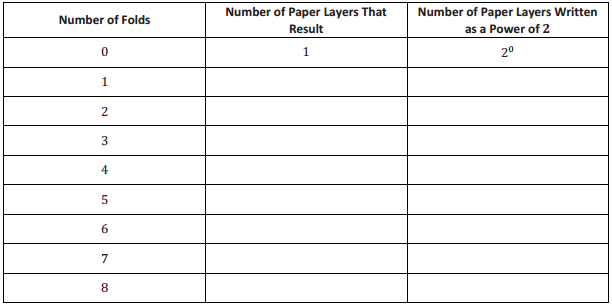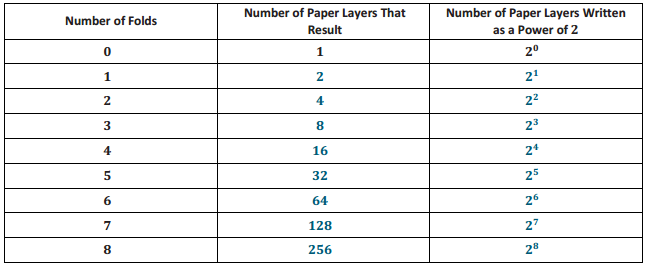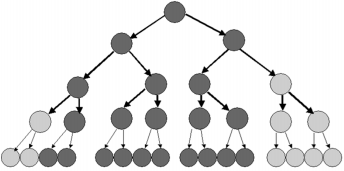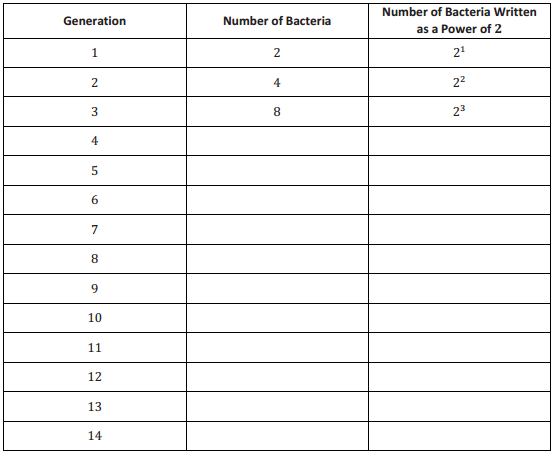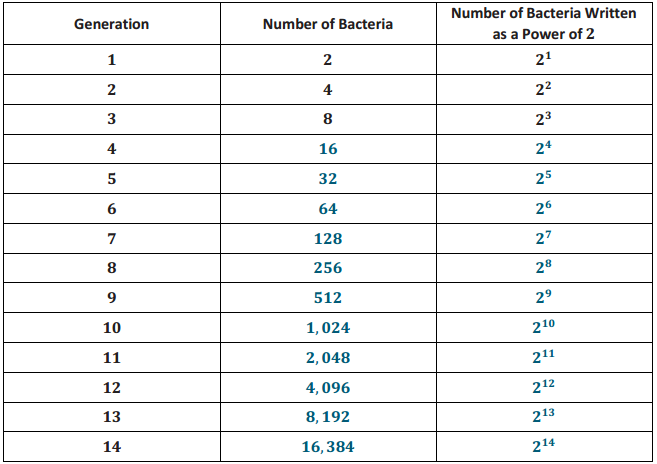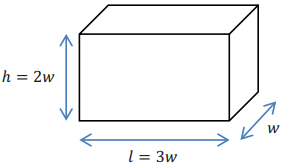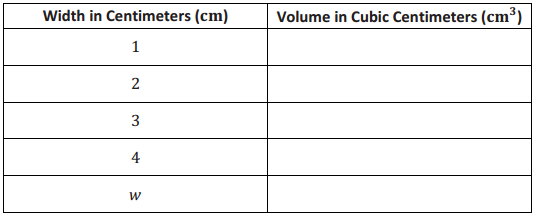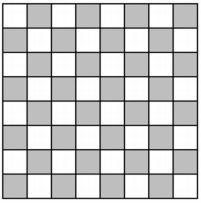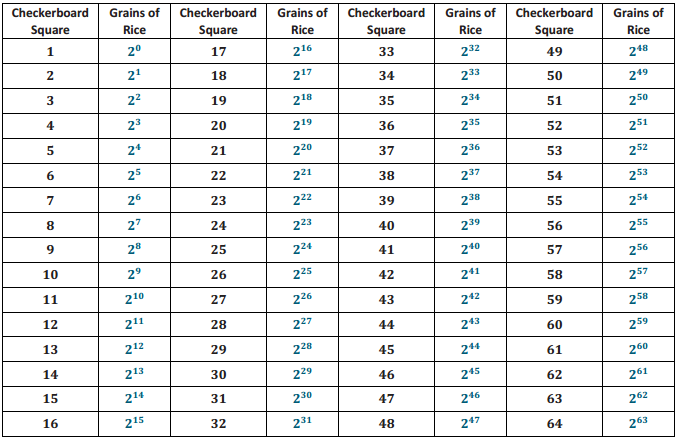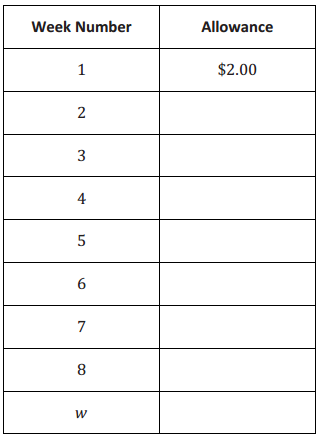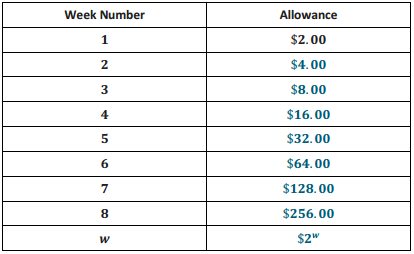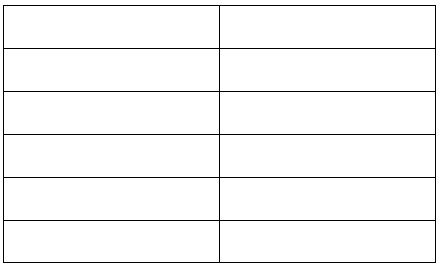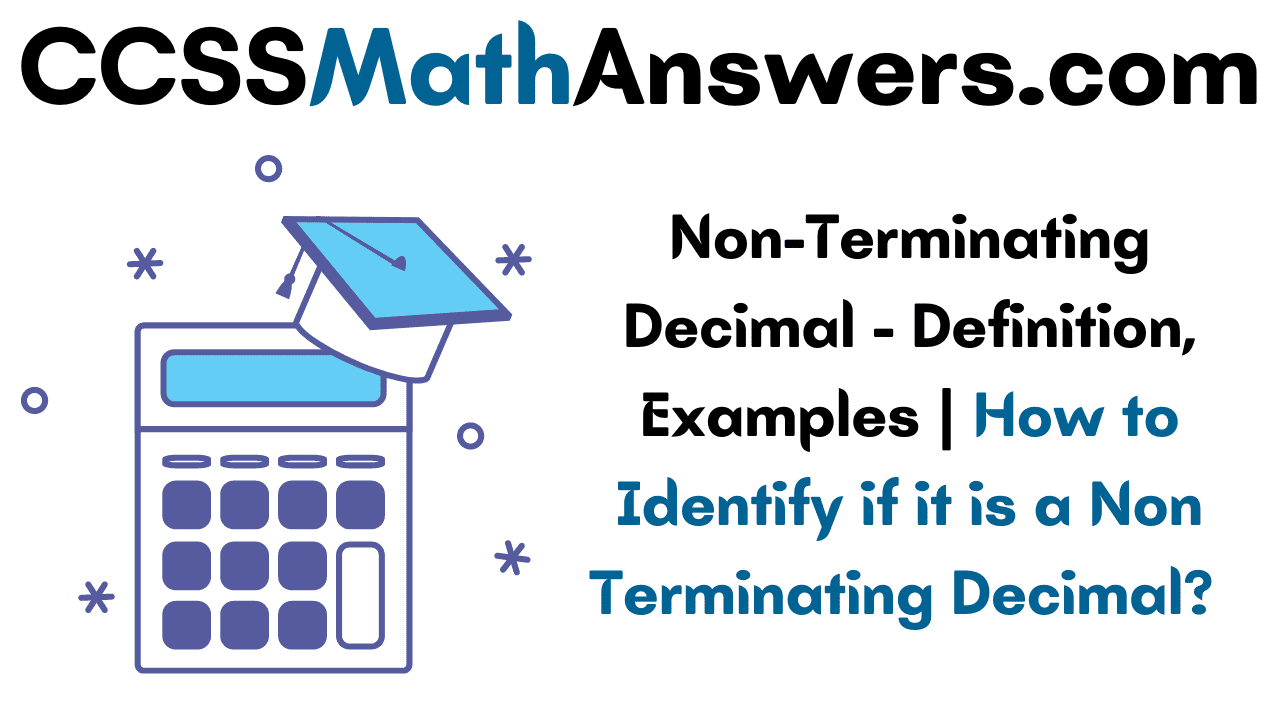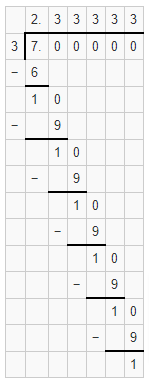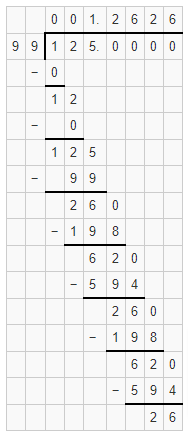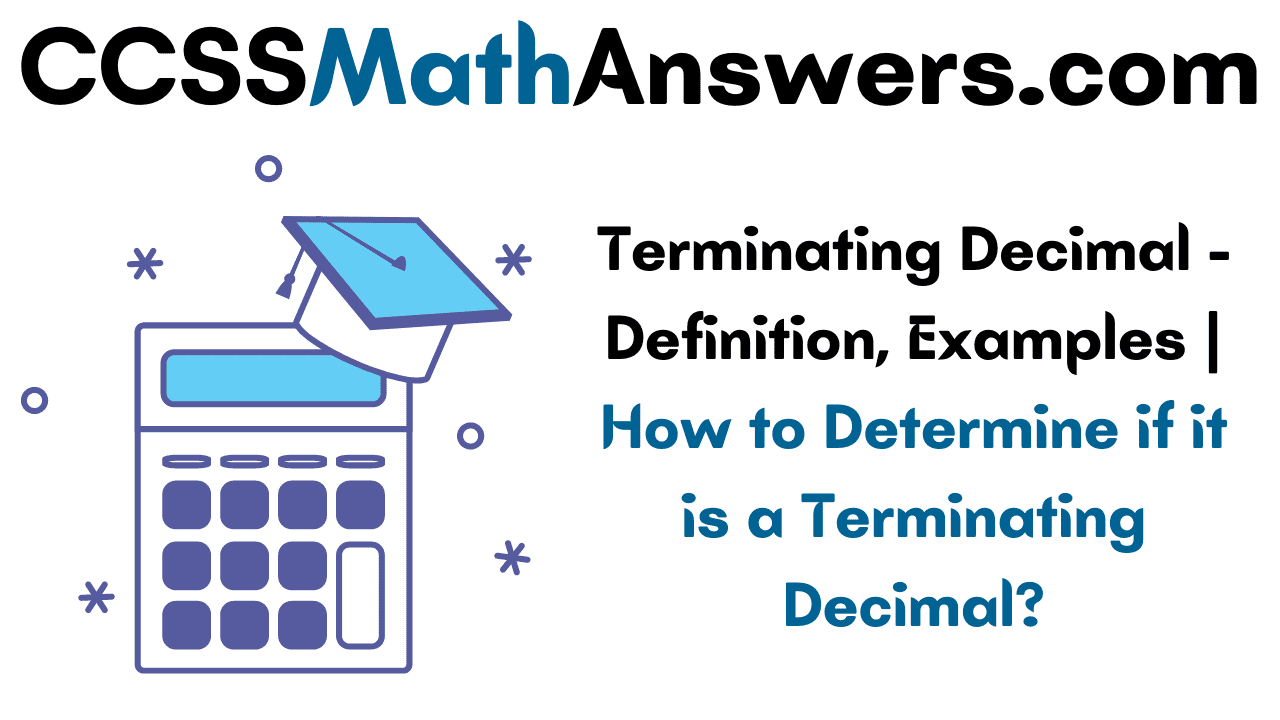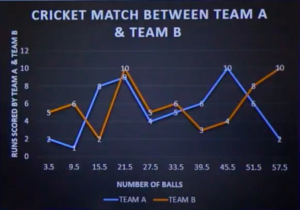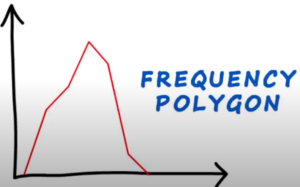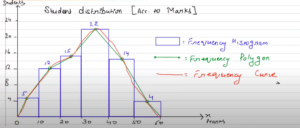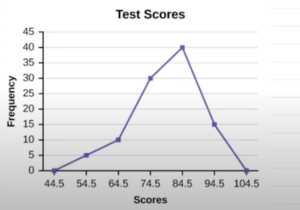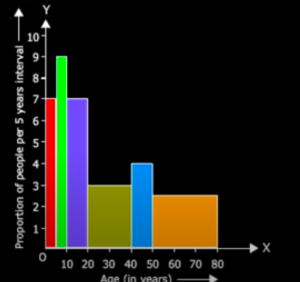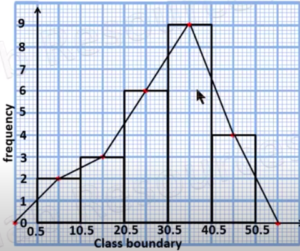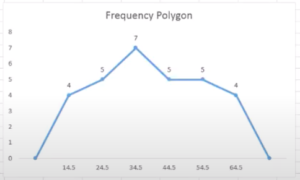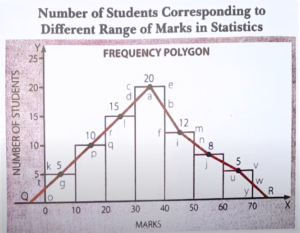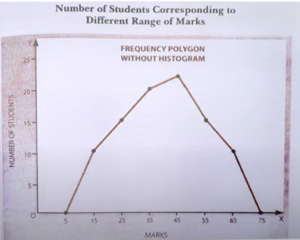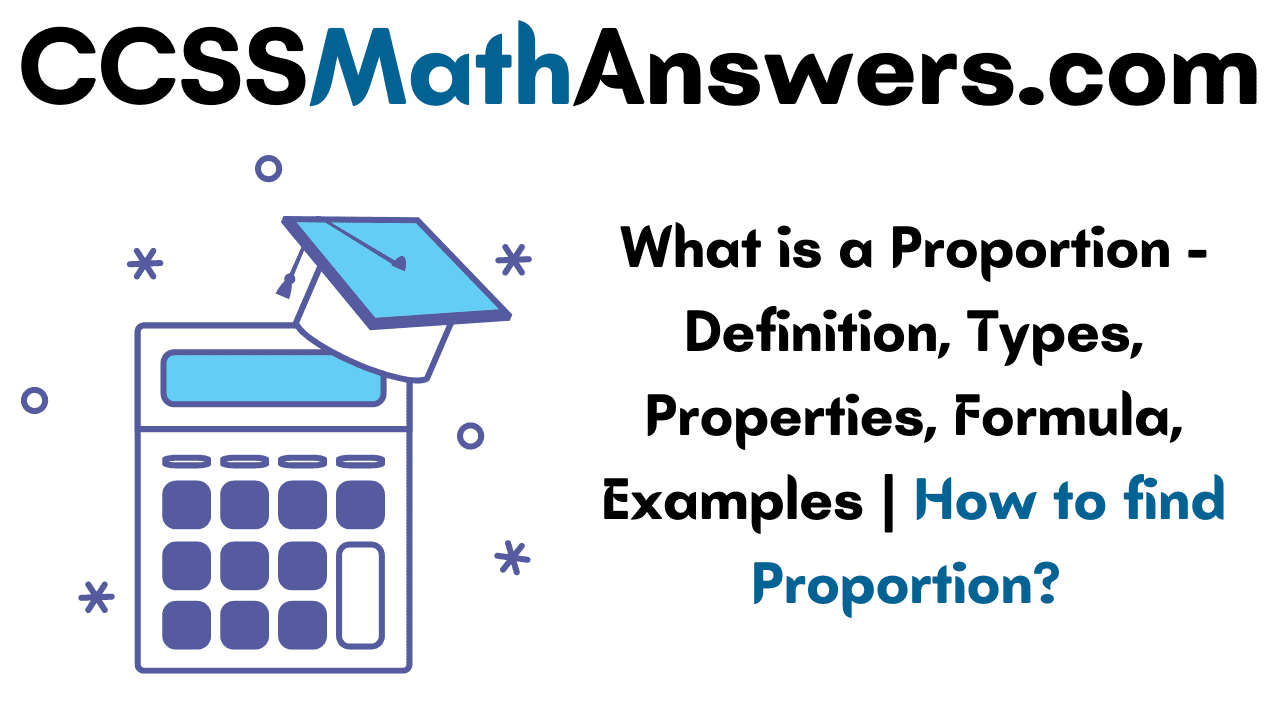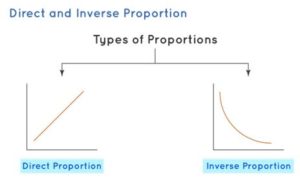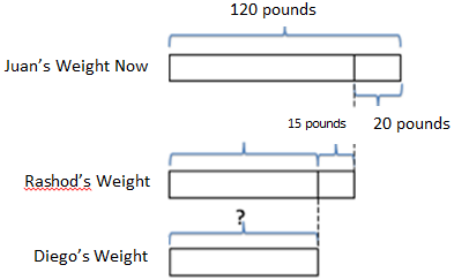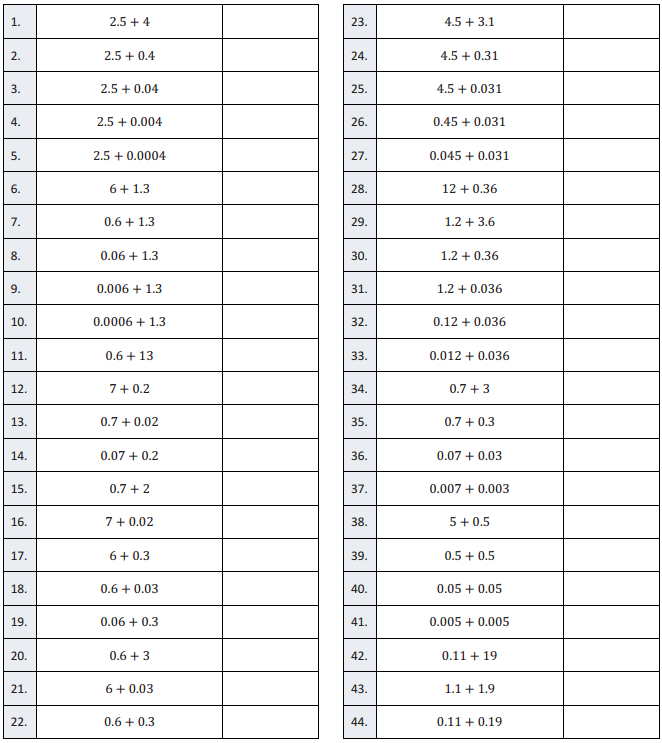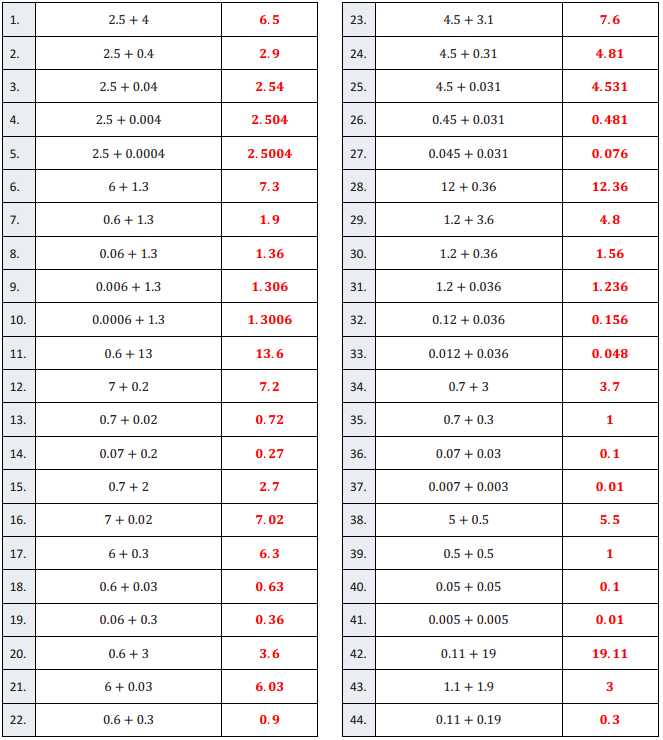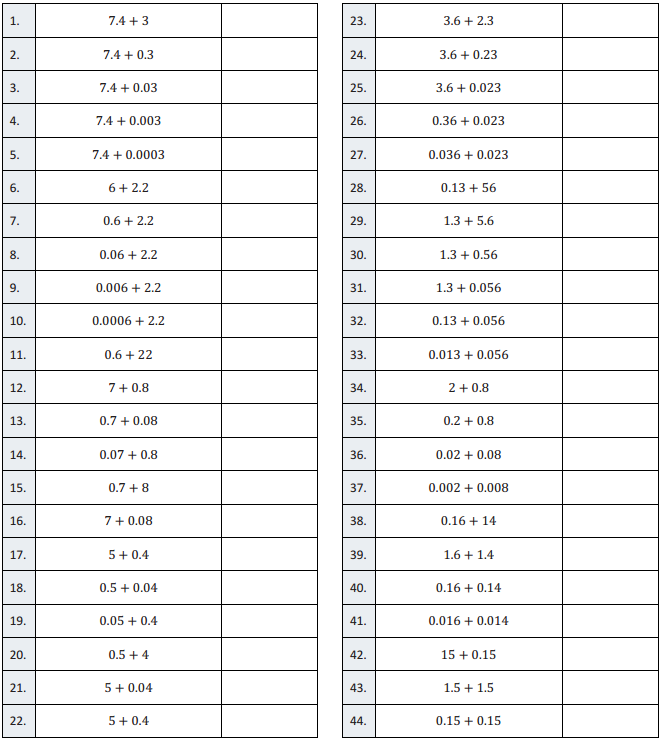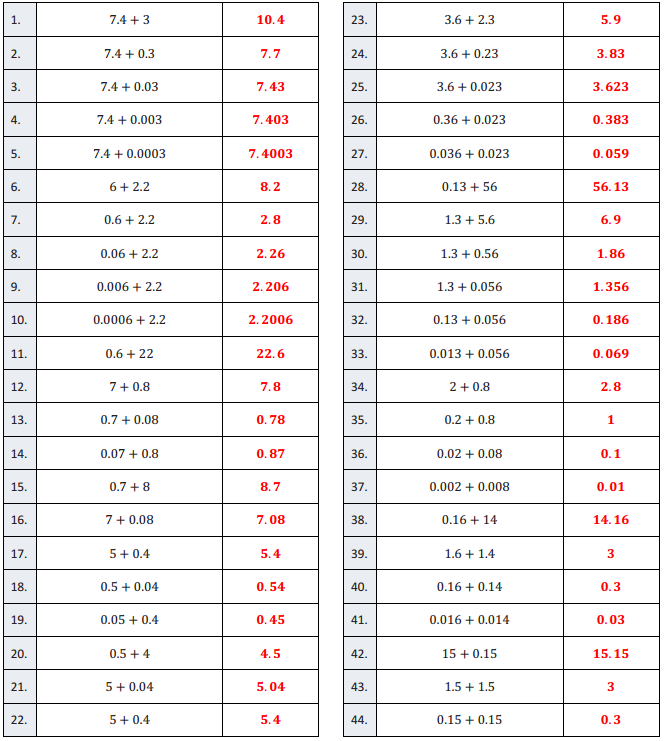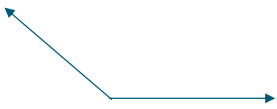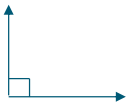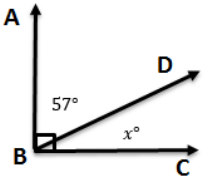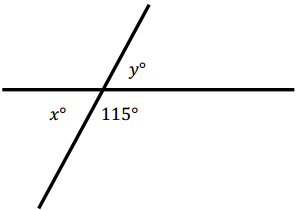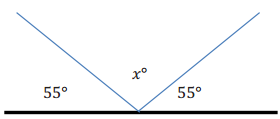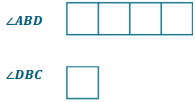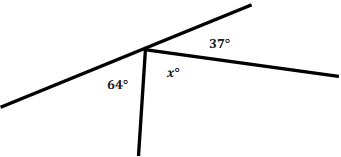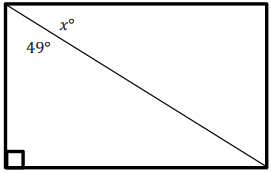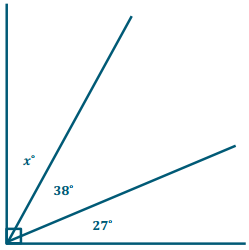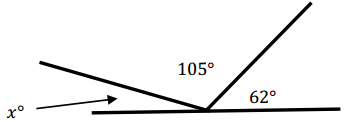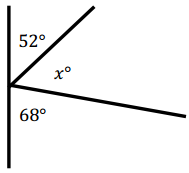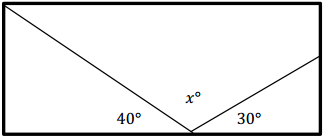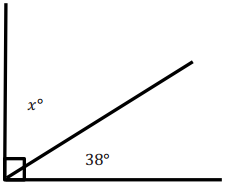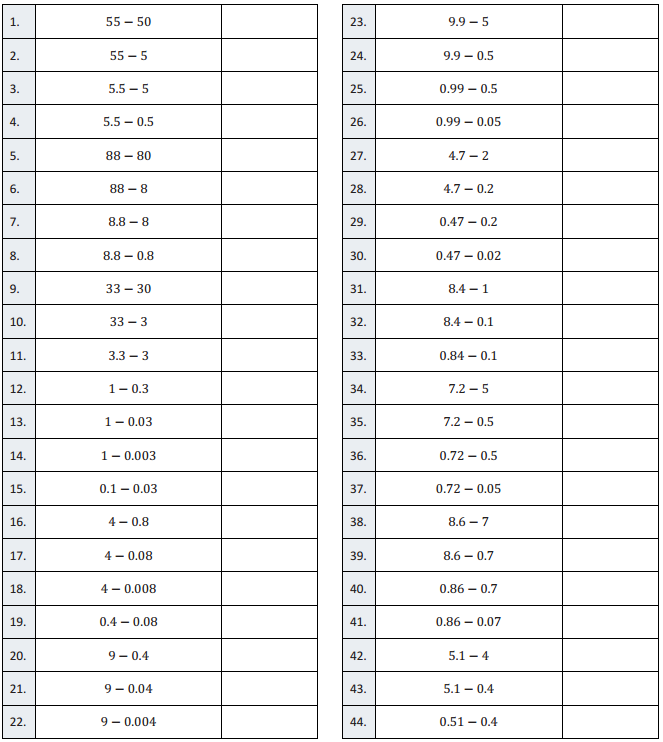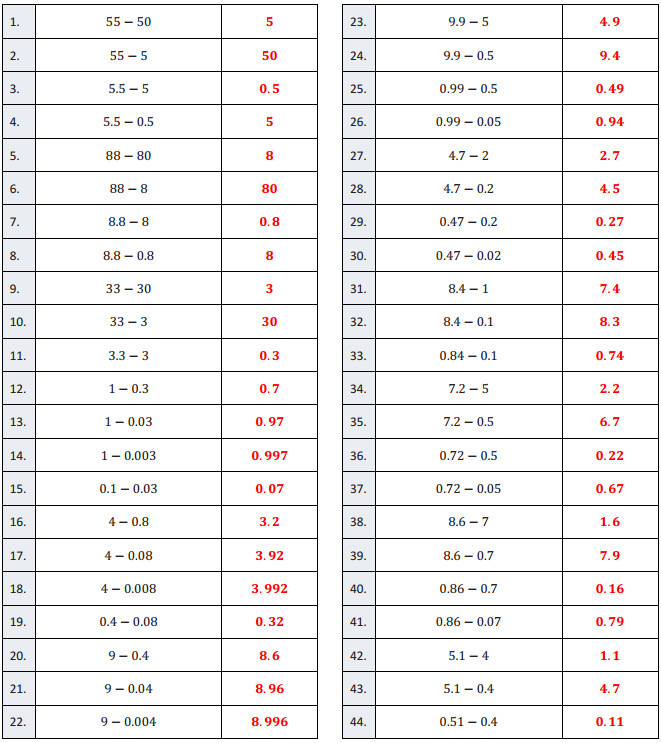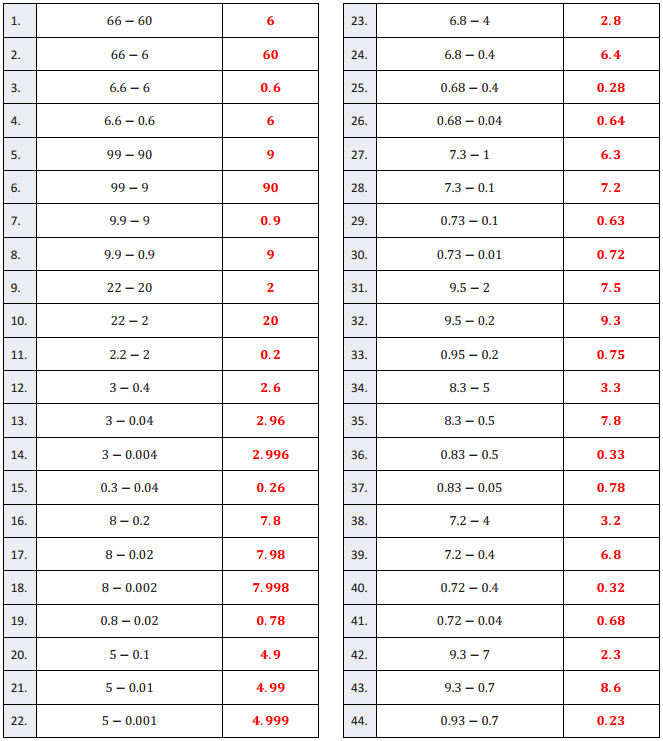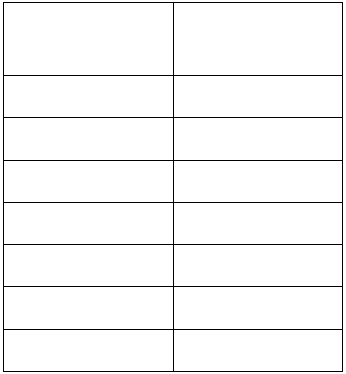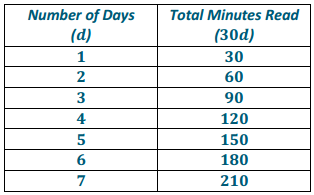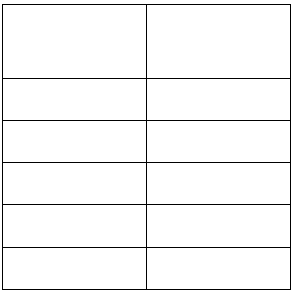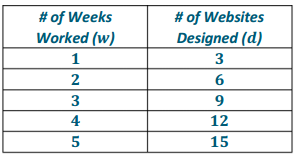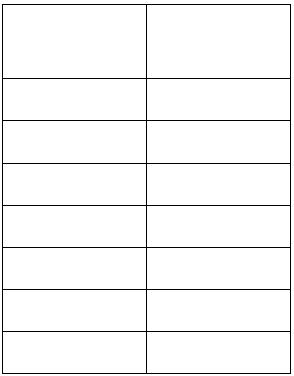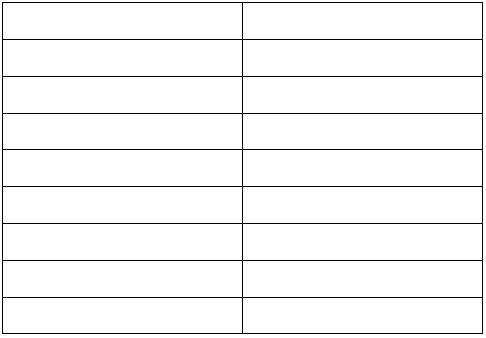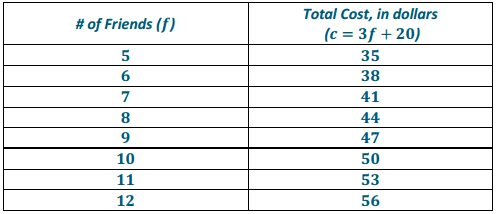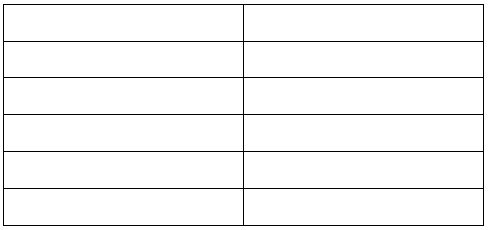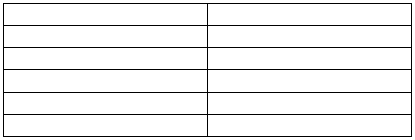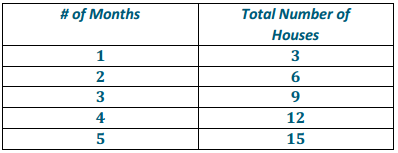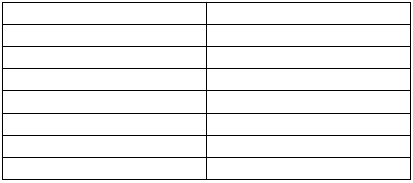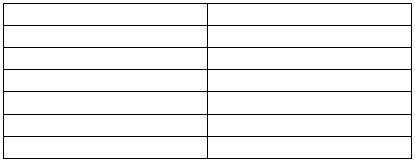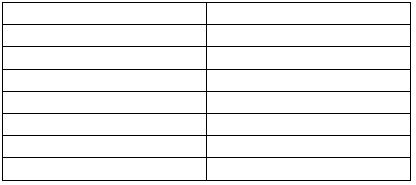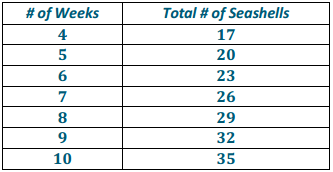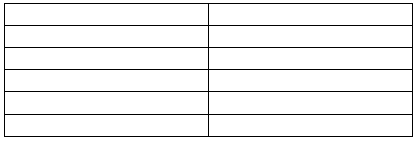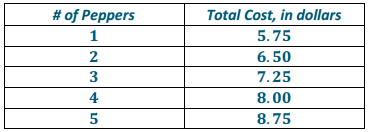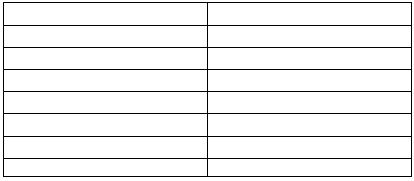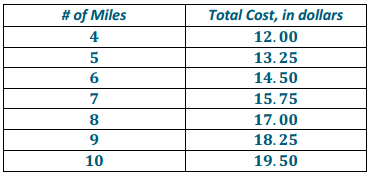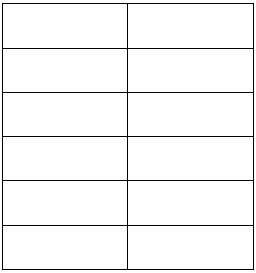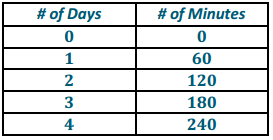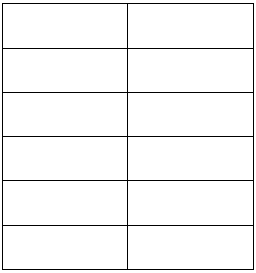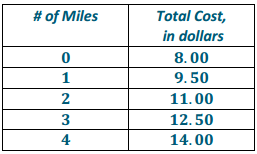Engage NY Eureka Math Grade 6 Module 4 Lesson 25 Answer Key
Eureka Math Grade 6 Module 4 Lesson 25 Opening Exercise Answer Key
Opening Exercise:
Identify a value for the variable that would make each equation or inequality into a true number sentence. Is this the only possible answer? State when the equation or inequality is true using equality and inequality symbols.
a. 3 + g = 15
Answer:
12 is the only value of g that will make the equation true. The equation is true when g = 12.
b. 30 > 2d
Answer:
Answers will vary. There is more than one value of d that will make the inequality true. The inequality is true when d < 15.
c. \(\frac{15}{f}\) < 5
Answer:
Answers will vary. There is more than one value off that will make the inequality true. The inequality is true when f > 3.
d. 42 ≤ 50 – m
Answer:
Answers will vary. There is more than one value of m that will make the inequality true. The inequality is true when m ≤ 8.
Eureka Math Grade 6 Module 4 Lesson 25 Example Answer Key
Example:
Each of the following numbers, if substituted for the variable, makes one of the equations below into a true number sentence. Match the number to that equation: 3, 6, 15, 16, 44.
a. n + 26 = 32
Answer:
6
b. n – 12 = 32
Answer:
44
c. 17n = 51
Answer:
3
d. 42 = n
Answer:
16
e. \(\frac{n}{3}\) = 5
Answer:
15
Eureka Math Grade 6 Module 4 Lesson 25 Problem Set Answer Key
Find the solution to each equation.
Question 1.
43 = y
Answer:
y = 64
Question 2.
8a = 24
Answer:
a = 3
Question 3.
32 = g – 4
Answer:
g = 36
Question 4.
56 = j + 29
Answer:
j = 27
Question 5.
\(\frac{48}{r}\) = 12
Answer:
r = 4
Question 6.
k = 15 – 9
k = 6
Question 7.
x . \(\frac{1}{5}\) = 60
Answer:
x = 300
Question 8.
m + 3 . 45 = 12 . 8
Answer:
m = 9 . 35
Question 9.
a = 15
Answer:
a = 1
Eureka Math Grade 6 Module 4 Lesson 25 Exit Ticket Answer Key
Find the solution to each equation.
Question 1.
7f = 49
Answer:
f = 7
Question 2.
1 = \(\frac{r}{12}\)
Answer:
r = 12
Question 3.
1.5 = d + 0.8
Answer:
d = 0.7
Question 4.
92 = h
Answer:
h = 81
Question 5.
q = 45 – 19
Answer:
q = 26
Question 6.
40 = \(\frac{1}{2}\)p
Answer:
p = 80
Eureka Math Grade 6 Module 4 Lesson 25 Division of Fractions Answer Key
Division of Fractions – Round 1:
Directions: Evaluate each expression and simplify:
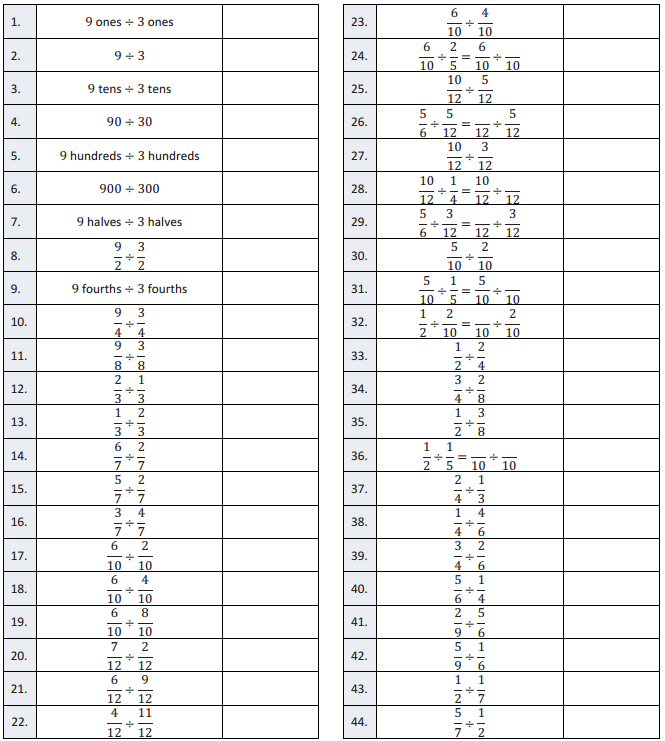
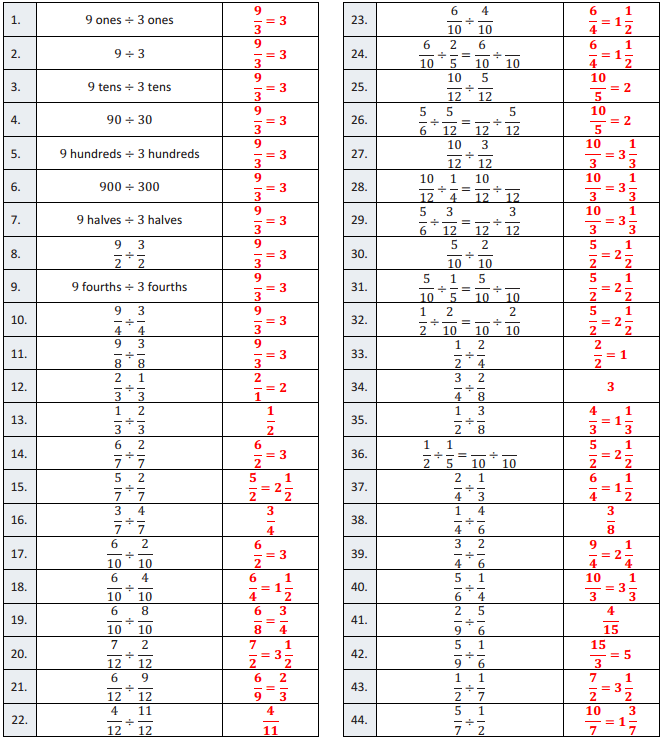
Question 1.
9 ones ÷ 3ones
Answer:
\(\frac{9}{3}\) = 3
Question 2.
9 ÷ 3
Answer:
\(\frac{9}{3}\) = 3
Question 3.
9tens ÷ 3tens
Answer:
\(\frac{9}{3}\) = 3
Question 4.
90 ÷ 30
Answer:
\(\frac{9}{3}\) = 3
Question 5.
9 hundreds ÷ 3 hundreds
Answer:
\(\frac{9}{3}\) = 3
Question 6.
900 ÷ 300
Answer:
\(\frac{9}{3}\) = 3
Question 7.
9 halves ÷ 3 halves
Answer:
\(\frac{9}{3}\) = 3
Question 8.
\(\frac{9}{2}\) ÷ \(\frac{9}{2}\)
Answer:
\(\frac{9}{3}\) = 3
Question 9.
9 fourths ÷ 9 fourths
Answer:
\(\frac{9}{3}\) = 3
Question 10.
\(\frac{9}{4}\) \(\frac{3}{4}\)
Answer:
\(\frac{9}{3}\) = 3
Question 11.
\(\frac{9}{8}\) ÷ \(\frac{3}{8}\)
Answer:
\(\frac{9}{3}\) =3
Question 12.
\(\frac{2}{3}\) ÷ \(\frac{1}{3}\)
Answer:
\(\frac{2}{1}\) = 2
Question 13.
\(\frac{1}{3}\) ÷ \(\frac{2}{3}\)
Answer:
\(\frac{1}{2}\)
Question 14.
\(\frac{6}{7}\) ÷ \(\frac{2}{7}\)
Answer:
\(\frac{6}{2}\) = 3
Question 15.
\(\frac{5}{7}\) ÷ \(\frac{2}{7}\)
Answer:
\(\frac{5}{2}\) = 2\(\frac{1}{2}\)
Question 16.
\(\frac{3}{7}\) ÷ \(\frac{4}{7}\)
Answer:
\(\frac{3}{4}\)
Question 17.
\(\frac{6}{10}\) ÷ \(\frac{2}{10}\)
Answer:
\(\frac{6}{2}\) = 3
Question 18.
\(\frac{6}{10}\) ÷ \(\frac{4}{10}\)
Answer:
\(\frac{6}{4}\) = 1\(\frac{1}{2}\)
Question 19.
\(\frac{6}{10}\) ÷ \(\frac{8}{10}\)
Answer:
\(\frac{6}{8}\) = \(\frac{3}{4}\)
Question 20.
\(\frac{7}{12}\) \(\frac{2}{12}\)
Answer:
\(\frac{7}{2}\) = 3\(\frac{1}{2}\)
Question 21.
\(\frac{6}{12}\) ÷ \(\frac{9}{12}\)
Answer:
\(\frac{6}{9}\) = \(\frac{2}{3}\)
Question 22.
\(\frac{4}{12}\) ÷ \(\frac{11}{12}\)
Answer:
\(\frac{4}{11}\)
Question 23.
\(\frac{6}{10}\) \(\frac{4}{10}\)
Answer:
\(\frac{6}{4}\) = 1\(\frac{1}{2}\)
Question 24.
\(\frac{9}{3}\) ÷ \(\frac{9}{3}\) = \(\frac{9}{3}\) ÷ \(\overline{10}\)
Answer:
\(\frac{6}{4}\) = 1\(\frac{1}{2}\)
Question 25.
\(\frac{10}{12}\) \(\frac{5}{12}\)
Answer:
\(\frac{10}{5}\) = 2
Question 26.
\(\frac{6}{4}\) ÷ \(\frac{6}{4}\) = \(\frac{6}{4}\) ÷ \(\overline{10}\)
Answer:
\(\frac{10}{5}\) = 2
Question 27.
\(\frac{10}{12}\) ÷ \(\frac{3}{12}\)
Answer:
\(\frac{10}{3}\) = 3\(\frac{1}{3}\)
Question 28.
\(\frac{10}{12}\) ÷ \(\frac{1}{4}\) = \(\frac{10}{12}\) ÷ \(\overline{10}\)
Answer:
\(\frac{10}{3}\) = 3\(\frac{1}{3}\)
Question 29.
\(\frac{5}{6}\) ÷ \(\frac{3}{12}\) = \(\overline{10}\) ÷ \(\frac{3}{12}\)
Answer:
\(\frac{10}{3}\) = 3\(\frac{1}{3}\)
Question 30.
\(\frac{5}{10}\) \(\frac{2}{10}\)
Answer:
\(\frac{5}{2}\) = 2\(\frac{1}{2}\)
Question 31.
\(\frac{5}{10}\) ÷ \(\frac{1}{5}\) = \(\frac{5}{10}\) ÷ \(\overline{10}\)
Answer:
\(\frac{5}{2}\) = 2\(\frac{1}{2}\)
Question 32.
\(\frac{1}{2}\) ÷ \(\frac{2}{10}\) = \(\overline{10}\) ÷ \(\frac{2}{10}\)
Answer:
\(\frac{5}{2}\) = 2\(\frac{1}{2}\)
Question 33.
\(\frac{1}{2}\) ÷ \(\frac{2}{4}\)
Answer:
\(\frac{1}{2}\) = 1
Question 34.
\(\frac{3}{4}\) ÷ \(\frac{2}{8}\)
Answer:
3
Question 35.
\(\frac{1}{2}\) ÷ \(\frac{3}{8}\)
Answer:
\(\frac{4}{3}\) = 1\(\frac{1}{3}\)
Question 36.
\(\frac{1}{2}\) ÷ \(\frac{1}{5}\) = \(\overline{10}\) ÷ \(\overline{10}\)
Answer:
\(\frac{5}{2}\) = 2\(\frac{1}{2}\)
Question 37.
\(\frac{2}{4}\) ÷ \(\frac{1}{3}\)
Answer:
\(\frac{6}{4}\) = 1\(\frac{1}{2}\)
Question 38.
\(\frac{1}{4}\) ÷ \(\frac{4}{6}\)
Answer:
\(\frac{3}{8}\)
Question 39.
\(\frac{3}{4}\) ÷ \(\frac{2}{6}\)
Answer:
\(\frac{9}{4}\) = 2\(\frac{1}{2}\)
Question 40.
\(\frac{5}{6}\) ÷ \(\frac{1}{4}\)
Answer:
\(\frac{10}{3}\) = 3\(\frac{1}{3}\)
Question 41.
\(\frac{2}{9}\) ÷ \(\frac{5}{6}\)
Answer:
\(\frac{4}{15}\)
Question 42.
\(\frac{5}{9}\) ÷ \(\frac{1}{6}\)
Answer:
\(\frac{15}{3}\) = 5
Question 43.
\(\frac{1}{2}\) ÷ \(\frac{1}{7}\)
Answer:
\(\frac{7}{2}\) = 3\(\frac{1}{2}\)
Question 44.
\(\frac{5}{7}\) ÷ \(\frac{1}{2}\)
Answer:
\(\frac{10}{7}\) = 1\(\frac{3}{7}\)
Division of Fractions – Round 2:
Directions: Evaluate each expression:
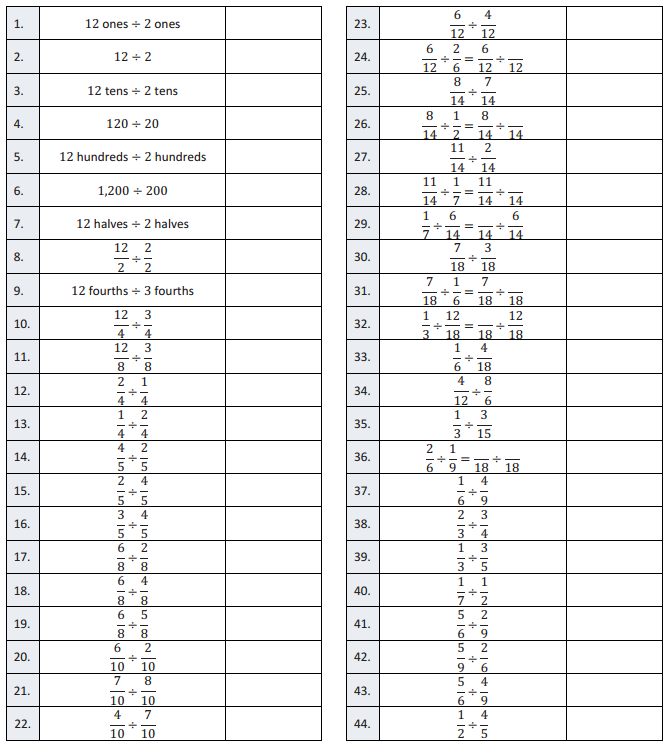
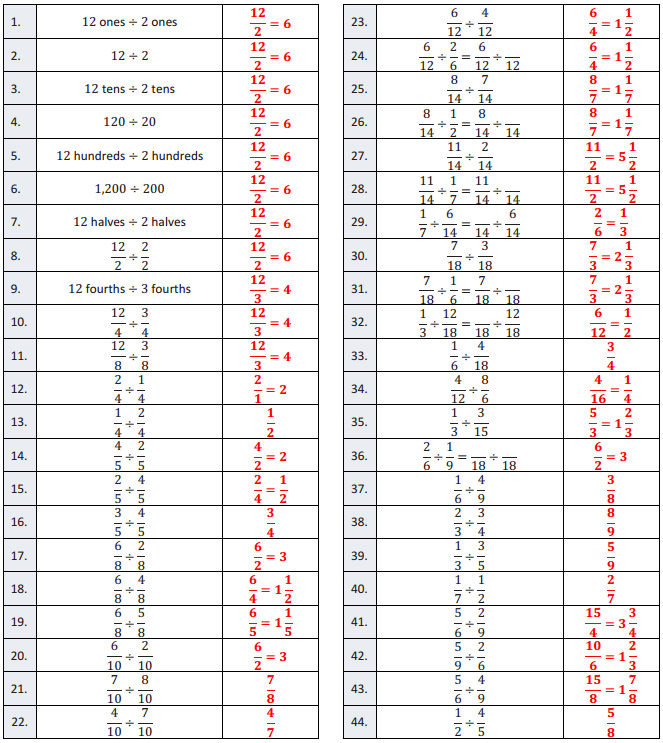
Question 1.
12ones ÷ 2ones
Answer:
\(\frac{12}{2}\) = 6
Question 2.
12 ÷ 2
Answer:
\(\frac{12}{2}\) = 6
Question 3.
12tens ÷ 2tens
Answer:
\(\frac{12}{2}\) = 6
Question 4.
120 ÷ 20
Answer:
\(\frac{12}{2}\) = 6
Question 5.
12 hundreds ÷ 2 hundreds
Answer:
\(\frac{12}{2}\) = 6
Question 6.
1,200 ÷ 200
Answer:
\(\frac{12}{2}\) = 6
Question 7.
12 halves ÷ 2 halves
Answer:
\(\frac{12}{2}\) = 6
Question 8.
\(\frac{12}{2}\) ÷ \(\frac{2}{2}\)
Answer:
\(\frac{12}{2}\) = 6
Question 9.
12 fourths ÷ 3 fourths
Answer:
\(\frac{12}{3}\) = 4
Question 10.
\(\frac{12}{4}\) ÷ \(\frac{12}{2}\)
Answer:
\(\frac{12}{3}\) = 4
Question 11.
\(\frac{12}{8}\) ÷ \(\frac{3}{8}\)
Answer:
\(\frac{12}{2}\) = 4
Question 12.
\(\frac{2}{4}\) ÷ \(\frac{1}{4}\)
Answer:
\(\frac{2}{1}\) = 2
Question 13.
\(\frac{1}{4}\) ÷ \(\frac{2}{4}\)
Answer:
\(\frac{1}{2}\)
Question 14.
\(\frac{4}{5}\) ÷ \(\frac{2}{5}\)
Answer:
\(\frac{4}{2}\) = 2
Question 15.
\(\frac{2}{5}\) ÷ \(\frac{4}{5}\)
Answer:
\(\frac{2}{4}\) = \(\frac{1}{2}\)
Question 16.
\(\frac{3}{5}\) ÷ \(\frac{4}{5}\)
Answer:
\(\frac{3}{4}\)
Question 17.
\(\frac{6}{8}\) ÷ \(\frac{2}{8}\)
Answer:
\(\frac{6}{2}\) = 3
Question 18.
\(\frac{6}{8}\) ÷ \(\frac{4}{8}\)
Answer:
\(\frac{6}{4}\) = 1\(\frac{1}{2}\)
Question 19.
\(\frac{6}{8}\) ÷ \(\frac{5}{8}\)
Answer:
\(\frac{6}{5}\) = 1\(\frac{1}{5}\)
Question 20.
\(\frac{6}{10}\) ÷ \(\frac{2}{10}\)
Answer:
\(\frac{6}{2}\) = 3
Question 21.
\(\frac{7}{10}\) ÷ \(\frac{8}{10}\)
Answer:
\(\frac{7}{8}\)
Question 22.
\(\frac{4}{10}\) ÷ \(\frac{7}{10}\)
Answer:
\(\frac{4}{7}\)
Question 23.
\(\frac{6}{12}\) ÷ \(\frac{4}{12}\)
Answer:
\(\frac{6}{4}\) = 1\(\frac{1}{2}\)
Question 24.
\(\frac{6}{12}\) ÷ \(\frac{2}{6}\) = \(\frac{6}{12}\) ÷ \(\overline{12}\)
Answer:
\(\frac{6}{4}\) = 1\(\frac{1}{2}\)
Question 25.
\(\frac{8}{14}\) ÷ \(\frac{7}{14}\)
Answer:
\(\frac{8}{7}\) = 1\(\frac{1}{7}\)
Question 26.
\(\frac{8}{14}\) ÷ \(\frac{1}{2}\) = \(\frac{8}{14}\) ÷ \(\overline{14}\)
Answer:
\(\frac{8}{7}\) = 1\(\frac{1}{7}\)
Question 27.
\(\frac{11}{14}\) = \(\frac{2}{14}\)
Answer:
\(\frac{11}{2}\) = 5\(\frac{1}{2}\)
Question 28.
\(\frac{11}{14}\) ÷ \(\frac{1}{7}\) = \(\frac{11}{14}\) ÷ \(\overline{14}\)
Answer:
\(\frac{11}{2}\) = 5\(\frac{1}{2}\)
Question 29.
\(\frac{1}{7}\) ÷ \(\frac{6}{14}\) = \(\overline{14}\) ÷ \(\frac{6}{14}\)
Answer:
\(\frac{2}{6}\) = \(\frac{1}{3}\)
Question 30.
\(\frac{7}{18}\) ÷ \(\frac{3}{18}\)
Answer:
\(\frac{7}{3}\) = 2\(\frac{1}{3}\)
Question 31.
\(\frac{7}{18}\) ÷ \(\frac{1}{6}\) = \(\frac{7}{18}\) ÷ \(\overline{18}\)
Answer:
\(\frac{7}{3}\) = 2\(\frac{1}{3}\)
Question 32.
\(\frac{1}{3}\) ÷ \(\frac{12}{18}\) = \(\overline{18}\) ÷ \(\frac{12}{18}\)
Answer:
\(\frac{6}{12}\) = \(\frac{1}{2}\)
Question 33.
\(\frac{1}{6}\) ÷ \(\frac{4}{18}\)
Answer:
\(\frac{3}{4}\)
Question 34.
\(\frac{4}{12}\) ÷ \(\frac{8}{6}\)
Answer:
\(\frac{4}{16}\) = \(\frac{1}{4}\)
Question 35.
\(\frac{1}{3}\) ÷ \(\frac{3}{15}\)
Answer:
\(\frac{5}{3}\) = 1\(\frac{2}{3}\)
Question 36.
\(\frac{2}{6}\) ÷ \(\frac{1}{9}\) = \(\overline{18}\) ÷ \(\overline{18}\)
Answer:
\(\frac{6}{2}\) = 3
Question 37.
\(\frac{1}{6}\) ÷ \(\frac{4}{9}\)
Answer:
\(\frac{3}{8}\)
Question 38.
\(\frac{2}{3}\) ÷ \(\frac{3}{4}\)
Answer:
\(\frac{8}{9}\)
Question 39.
\(\frac{1}{3}\) ÷ \(\frac{3}{5}\)
Answer:
\(\frac{5}{9}\)
Question 40.
\(\frac{1}{7}\) ÷ \(\frac{1}{2}\)
Answer:
\(\frac{2}{7}\)
Question 41.
\(\frac{5}{6}\) ÷ \(\frac{2}{9}\)
Answer:
\(\frac{15}{4}\) = 3\(\frac{3}{4}\)
Question 42.
\(\frac{5}{9}\) ÷ \(\frac{2}{6}\)
Answer:
\(\frac{10}{6}\) = 1\(\frac{2}{3}\)
Question 43.
\(\frac{5}{6}\) ÷ \(\frac{4}{9}\)
Answer:
\(\frac{15}{8}\) = 1\(\frac{7}{8}\)
Question 44.
\(\frac{1}{2}\) ÷ \(\frac{4}{5}\)
Answer:
\(\frac{5}{8}\)






